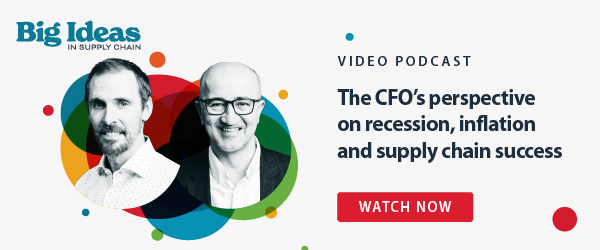If there's one constant in supply chain planning, it's that there will always be new challenges to handle. The existing macroeconomic environment is tumultuous as a potential global recession, inflation rates and other volatilities continue to cause hurdles for supply chain leaders. No industry is immune to these crises, so it’s become more important than ever to use the right tools to sense and respond to these disruptions.
In our latest video podcast, Blaine Fitzgerald, Chief Financial Officer at Kinaxis, and Jim Bralsford, Sr. Director of Industry and Solutions Marketing at Kinaxis, discuss the importance of preparing for an uncertain future. Specifically, why you need to make your supply chain more resilient and agile, how to create long-term action plans for your organization and what tools you need to help your company succeed financially.
Here are some key takeaways from their discussion.
Why your supply chain needs to plan for the long-term
Global challenges and disruptions aren’t slowing down. As recessionary periods continue to fluctuate around the world in a time when supply chains are still recovering from COVID-19, C-suites and financial executives are scrambling to minimize the impacts on their businesses.
As a result, many organizations are making the mistake of trying to solve for the short-term, rather than plan for the future. Blaine states that focusing only on short-term planning can actually harm your company in the long run because it impedes its ability to operate at full capacity when the crisis is over. “In supply chain right now, the most effective companies are already thinking about the next three to four to five years and are learning very quickly from the volatility that they're going through right now,” he says. “The ones that are suffering are the ones that are, you know, trying to follow up and make sure that they're reducing their costs as much as possible without thinking about the impact it is going to have in years three, four, and five. “
So, what can organizations do in the short-term to ensure they succeed in the future?
Blaine states that diversifying costs throughout your organization can help with long-term planning tactics. For instance, the effectiveness of onshoring in the short-term may not work well in the future if you consider the macroeconomic environment in the long run.
The right tools can help your supply chain get ahead of disruption
The best thing supply chains can do to get ahead of disruption is become more agile – and thanks to independent academic research conducted over the past three years, data exists to reinforce this.
This research1 was conducted across 700 companies across different industries, including Kinaxis customers. Results showed that companies using a digital supply chain planning tool like Kinaxis saw revenue growth during this period of COVID-related disruption. Companies that used advanced planning solutions saw a revenue increase of 3.62% while their peers saw a decrease of 5.77%.
As such, it’s clear that advanced planning solutions enable agility and more resilience within supply chains. Blaine says this type of agility is what will make those companies successful. “All their financial metrics are better off if they're using a solution such as Kinaxis. And, you know, that really needs to get into the heads of the CFOs and CEOs out there by saying, having these tools, having an ability to plan for the long-term, that is not only going to be something that’s going to have a cost impact in the early days, but it's going to make you into a company that would be very agile in the future.”
Why CFOs need to put more emphasis on supply chain
The ability to pivot within the supply chain is crucial when you consider upcoming global challenges. Blaine believes there’s a lot that we can learn from recent disruptions like the pandemic because of how long the impacts have lasted compared to other events like 9/11 or catastrophic natural disasters. “The pandemic is still here. COVID is still an issue [and] is disrupting things. It shone a light on how important understanding your supply chain was, how important it is on the financial model for your business.”
Blaine believes that more C-suites and CFOs should be more engaged in finding the right tools to manage supply chain disruption and that the best way to navigate an uncertain future is with transparency. “I'm very transparent. I think to make everyone better, I need to be efficient, and I need to have efficient communication. That means I need to educate people as much as possible with the direction we're going in. So, I'll be as transparent as I can to allow people to understand…the direction we need to go in.”
To hear more about recession, inflation and supply chain success from Blaine and Jim, watch the full video podcast here:
Watch more Big Ideas in Supply Chain Insights today!
Click to learn more about Blaine Fitzgerald.
Click to learn more about Jim Bralsford.
1. Supply Chain Transformation: The secret weapon to reach your financial targets. Kinaxis. April 18, 2023, from https://www.kinaxis.com/en/resources/content/cfo-resources/sc-transformation-financial-targets?utm_source=website&utm_medium=osr#page=1






